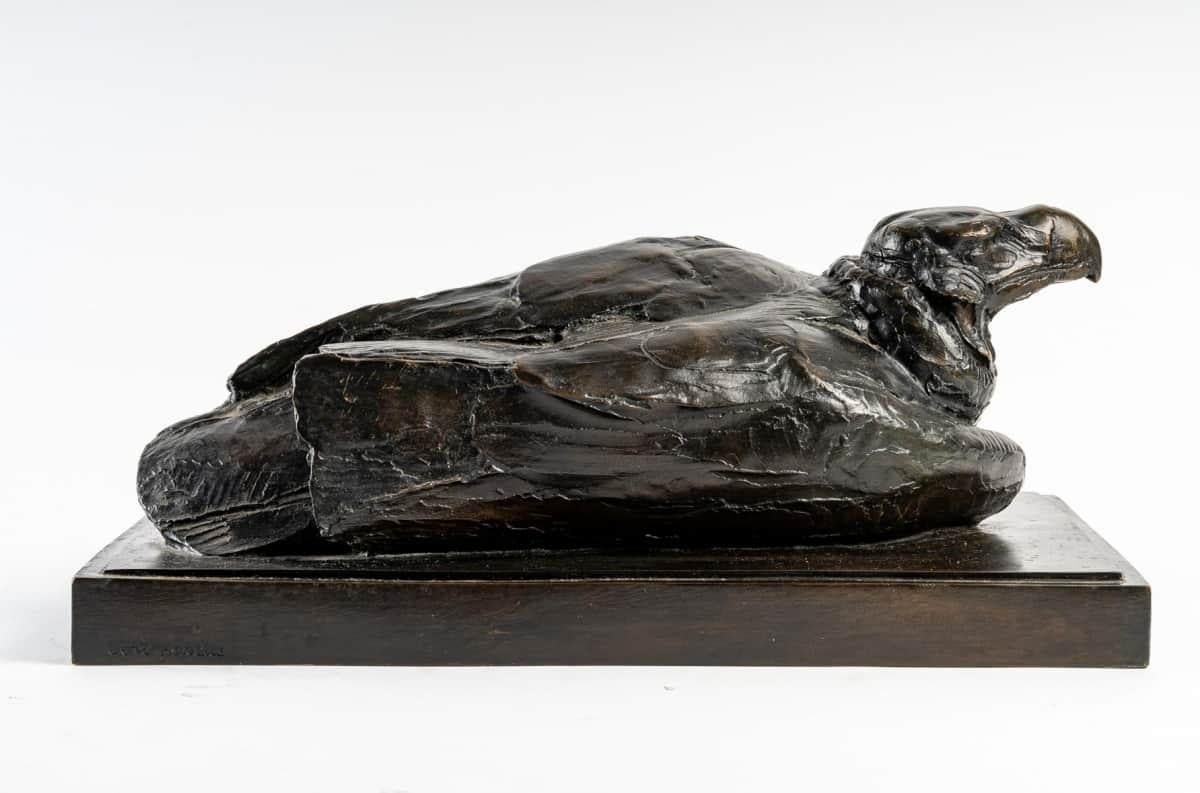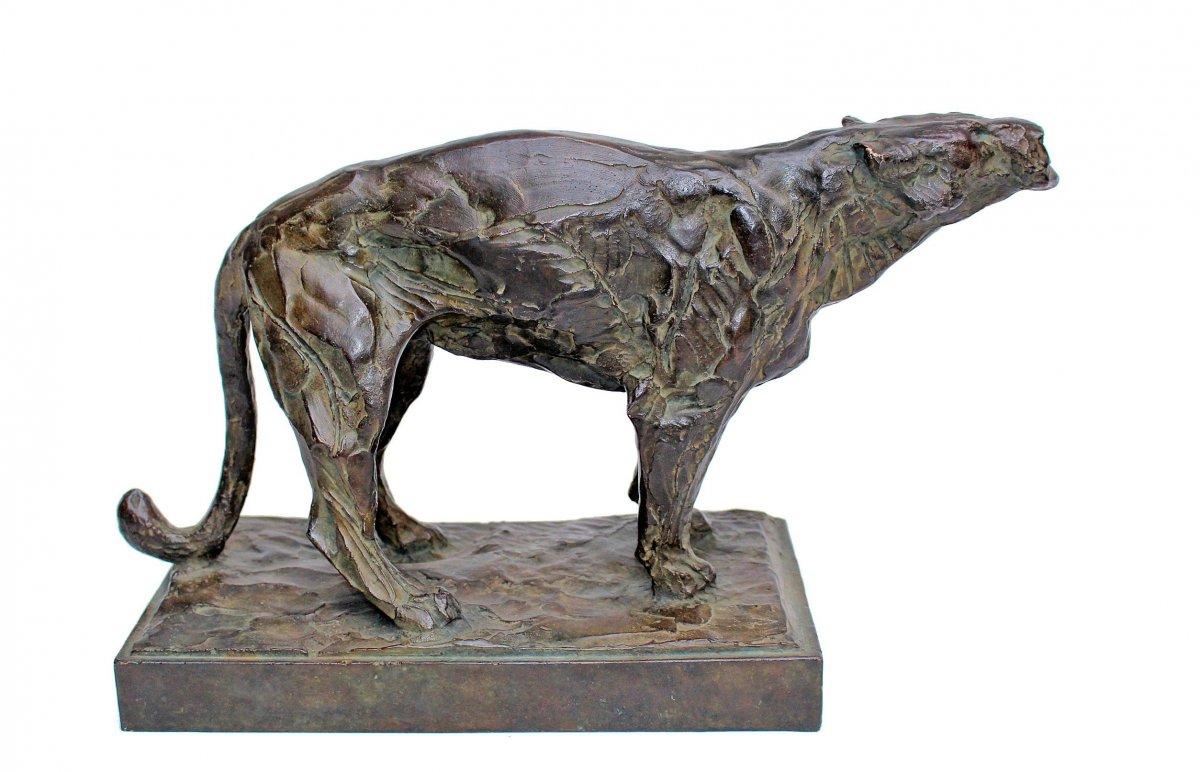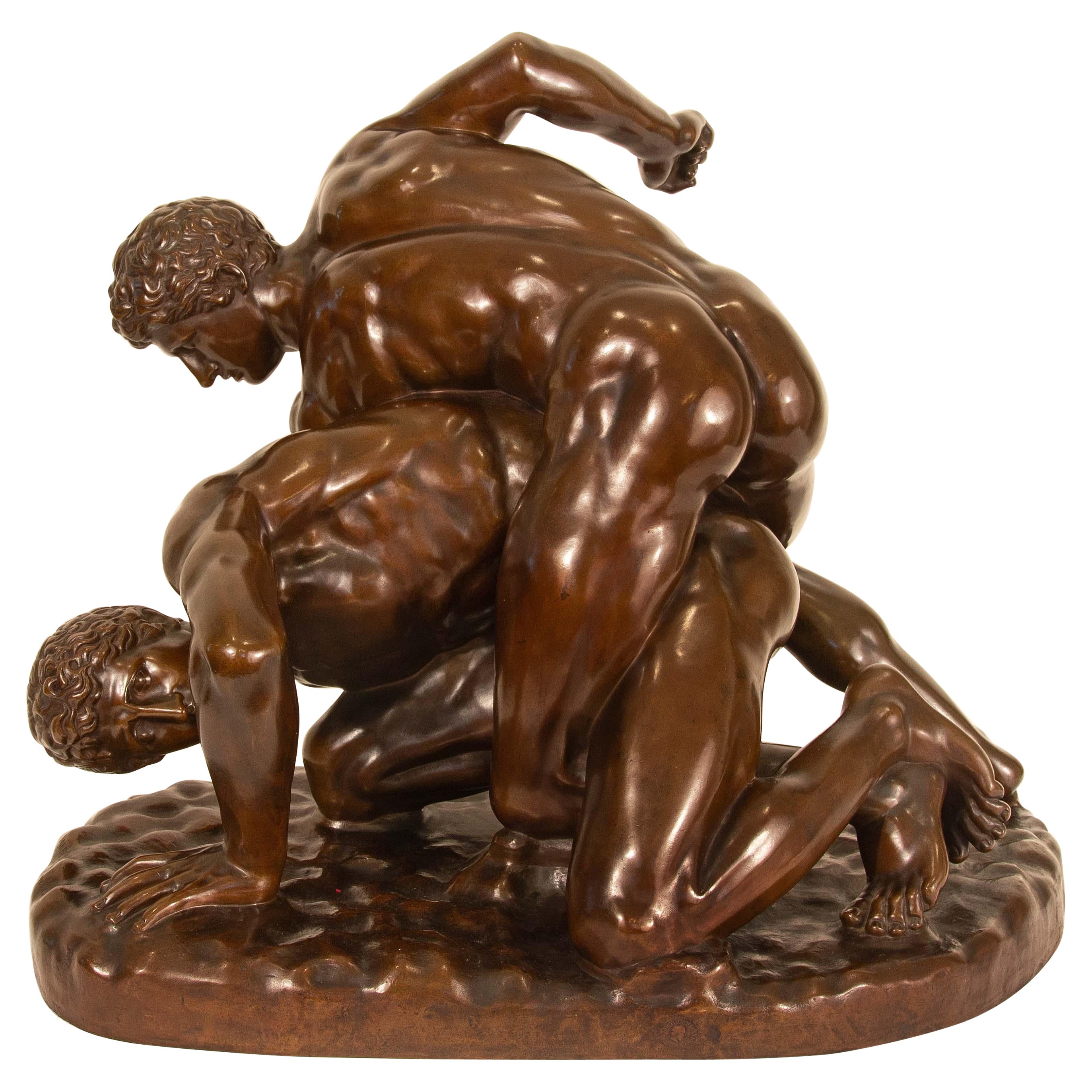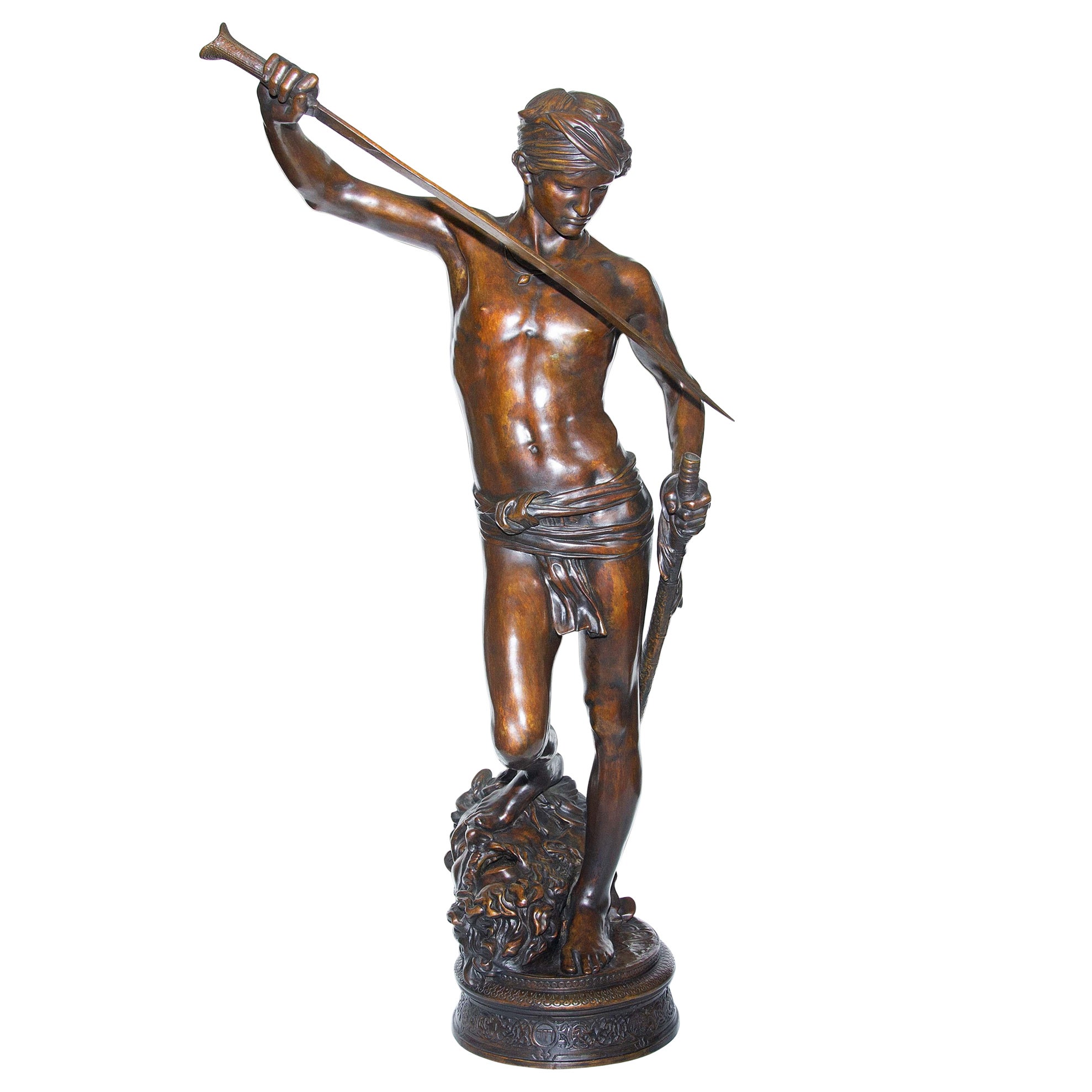Items Similar to Jean Garnier, L'Enfer des Luxurieux, The Hell of the Luxurious, Erotic Relief.
Want more images or videos?
Request additional images or videos from the seller
1 of 11
Jean-François Garnier Jean Garnier, L'Enfer des Luxurieux, The Hell of the Luxurious, Erotic Relief.c.1859-1864
c.1859-1864
About the Item
A rare round relief cast, elaborate chiseled bronze/copper with brown patina by Jean François Marie Garnier (1820-1895). Cast c.1859-1864. Not signed. The motif is taken from Dantes, The Divine Comedy´s, first part, Inferno and the second circle, called "L'Enfer des Luxurieux", in english "The Hell of the Luxurious". See identical relief, signed Jean Garnier, in Musée d'Orsay in Paris, inventory no. OA 3666, also belonging to the Louvre collections. Another cast of the relief is part of the Museum of Lyon collections. Framed in a 19th century stained oak frame. The dimensions are the exact as the one in Musée d'Orsay. Later copies, of which a few are known, usually have a larger diameter and lesser quality in casting etc.
The relief, L'Enfer des Luxurieux, in the Musée d'Orsay collection, was exhibited 2023-2024 during the exhibition: Louis Janmot, "The Poem of the Soul", in french 'Le Poème de l’âme'.
From the introduction text of the exhibition:
"The Poem of the Soul" suit was begun in Rome in 1835 and completed in 1881, The Poem of the Soul is the crowning achievement of the Lyonese artist Louis Janmot (1814-1892), a pictorial and literary work all in one. In 34 compositions accompanied by a long poem, it illustrates a soul’s initiatory journey on Earth.
Garnier and Janmot were both from Lyon and they probably knew each other and Garnier was likely inspired by Janmot´s work. Jean Francois Marie Garnier was born in Lyon and died in Paris. He is sometimes mixed up with another artist, with a very similar name, Alfred Jean Garnier (1848-1921).
During the 19th century, particularly with romanticism, then symbolism, the representation of the soul took on considerable importance. Artists respond in varied ways to the same iconographic problem: how to represent an immaterial entity, distinct from the body and having an existence beyond death? In turn, the soul takes the form of a winged female figure, an allegory of purity and spirituality, or materializes in the form of a shadow or a flow escaping from the body.
The second circle, in Dantes Inferno, depicted in this relief shows the fate of the damned souls, also called the “lustful”. The souls in this circle is to be swept away by relentless winds. All people guilty of the sin of lust are whirled round and round in an unending storm. The storm, represents irresistible passion. Among those being blown about are mythic and historical queens. The sin of these souls is that of having submitted reason to their carnal appetites, of having committed the sin of the flesh. Among them are the souls of Semiramis, Cleopatra, Dido, Helen of Troy, Paris, Tristan, Francesca da Rimini and Paolo Malatesta.
The two center figures embracing each other in the relief depicts Francesca da Rimini and Paolo Malatesta.
The Divine Comedy is a literary masterpiece written by Dante Alighieri (1265-1321) in the first half of the 14th century. The Comedy symbolises humankind’s journey for redemption through the three afterlife kingdoms: Inferno, Purgatory and Paradise.
While Purgatory and Paradise are embedded with theological and philosophical considerations, Inferno is a testimony of the political corruption at that time. Italy was the battlefield for the political fights between the Pope and the Emperor. It was one of the most merciless ‘Games of Thrones’ in medieval history.
Dante tells the story of many political and religious figures, who – blinded by political ambitious – committed murders, cannibalism, treason, and suicide all in the name of ‘worldly power’.
In a sense, Dante’s Inferno is the first attempt to challenge the dominant social imaginary through storytelling. Dante is aware that unless humanity achieves spiritual redemption, his world will be forever lost in the wood of sins and corruption.
Each circle that constitutes Hell introduces characters that embed a specific characteristic of the dominant imaginary that needs to be criticized. The only exception can be found in Canto V (chapter V), in which – only on this occasion- Dante took pity of two condemns: Paolo and Francesca di Rimini.
Canto V is the testimony of Dante’s powerful narrative technique that triggers empathy in the readers. Even though Paolo and Francesca committed adultery and therefore had to be put in the circle of the lustful, their love story is so moving that the readers conceive them as the innocent victims of a dreadful/unjust fate.
Francesca di Rimini was a beautiful noble girl – destined to become a nun – but she was kidnapped and forced to marry the violent Gianciotto Malatesta, Paolo’s older brother. While living together, Paolo and Francesca fell in love. Unfortunately, the brother discovered their affair and killed the two lovers, condemning his brother and his wife to an eternity in Hell. Nevertheless, Paolo and Francesca’ sin becomes secondary to the readers because what really matters is that their life was brutally interrupted. Paolo and Francesca can be finally together and free to live their love but they have to go through eternal suffering.
In this Canto, Dante uncommonly employs a sweet, romantic and poetic language. The words are characterized by a slow rhythm that creates emphasis and pathos to the story. The readers are capable of creating an emotional connection with the characters and cannot help identifying themselves with the pain and sorrow these two star-crossed lovers have to go through every day to be together.
Paolo and Francesca’s story is an outstanding example of the emotional power of language that may open doors to change and better justice.
- Creator:Jean-François Garnier (1820 - 1895, French)
- Creation Year:c.1859-1864
- Dimensions:Height: 1.19 in (3 cm)Diameter: 20.87 in (53 cm)
- Medium:
- Movement & Style:Symbolist
- Period:
- Condition:There are a few breakage places on the outer rim of the cast.
- Gallery Location:Stockholm, SE
- Reference Number:1stDibs: LU2608213929842
About the Seller
5.0
Vetted Seller
These experienced sellers undergo a comprehensive evaluation by our team of in-house experts.
1stDibs seller since 2023
5 sales on 1stDibs
Typical response time: 3 hours
- ShippingRetrieving quote...Ships From: Stockholm, Sweden
- Return PolicyA return for this item may be initiated within 14 days of delivery.
More From This SellerView All
- 16th Century Cameo Pendant of Christ the Redeemer in a Gilt Bronze FrameLocated in Stockholm, SEA finely carved 16th or early 17th century large hard stone pendant cameo of Christ the Redeemer in profile. Set in period a gilt bronze frame. Possibly Italian. The profile view of...Category
16th Century Italian School Figurative Sculptures
MaterialsPrecious Stone
- View over Buckingham Palace Garden, Big Ben and Westminster PalaceLocated in Stockholm, SEA fine watercolor by an unknown English artist with a view overlooking the Buckingham Palace garden and its lake, towards the West facade of the Buckingham Palace. In the distance on...Category
Late 19th Century English School Landscape Drawings and Watercolors
MaterialsPaper, Watercolor
- 19th Century Still-Life, A Lantern, Tankard, Wine Ewer, Apple and a ForkLocated in Stockholm, SEA charming 19th century still-life painted on canvas depicting an 18th century wine ewer, lantern, stoneware tankard with a blue ribbon bow, fork with a sculptured ivory handle, and ...Category
19th Century Still-life Paintings
MaterialsCanvas, Oil
- Allan Österlind, Spanish Flamenco Dancing WomenLocated in Stockholm, SEA fine painting of a group of Spanish flamenco dancing and music playing women outside a house in the garden by Allan Österlind (1855-1938) Österlin...Category
Early 20th Century Other Art Style Figurative Paintings
MaterialsCanvas, Oil
- Carl Brandt, Swedish Mountain Landscape, "Nolbykullen and Ljungan"Located in Stockholm, SEA Swedish mountain landscape with a river lake painted by Carl August Brandt (1871-1930). Oil on canvas painted in the early 1900´s. Signed C. Brandt. The view depicts Ljungan, a 399km long river, looking towards the mountain Nolbykullen and its surrounding mountainous landscape. Nolby is a place in Njurunda district (Njurunda parish) in Sundsvall municipality in Västernorrland county. It is located just south of the city of Sundsvall. Nolby is part of the Kvissle-Nolby-Prästbolet cultural environment of national interest. As an actual village, Nolby has existed since around 600 AD. Carl Brandt painted landscape motifs, mostly in pastels, but he also made oil paintings. In all his production he was consistently a romantic landscape painter. There were both summer and winter motifs with red cabins...Category
Early 20th Century Naturalistic Landscape Paintings
MaterialsOil
- Oriental Man Wearing a Fez. 19th Century.Located in Stockholm, SEA fine portrait of an oriental bearded man, wearing a fez and holding a walking stick, second half of the 19th century. Oil on canvas. Relined. Unknown artist but probably Swedish. ...Category
Late 19th Century Other Art Style Figurative Paintings
MaterialsCanvas, Oil
You May Also Like
- Animal Bronze: Lying eagle by Alberic Collin (close friend of Rembrandt Bugatti)Located in Gent, VOVNumbered 1/8 Cast Fonderie Rocher A fine cast with a vivid green patina of a bird of preyCategory
1930s Nude Sculptures
MaterialsBronze
- Roaring LionnessLocated in Gent, VOVA fine quality, twentieth-century bronze model of a roaring lioness by Alberic Collin (Belgian 1886-1962). Prior to casting by the Valsuani foundry it w...Category
1930s Art Deco Figurative Sculptures
MaterialsBronze
- Large Grand Tour Bronze Greco-Roman Uffizi Wrestlers Ferdinand BarbedienneBy F. Barbedienne FoundryLocated in Rochester, NYGrand tour circa 1860s bronze of the Wrestlers. Rich fine dark brown patina. Marked "F. Barbedienne Fondeur." The Wrestlers also known as The Two Wrestlers, The Uffizi Wrestlers...Category
Mid-19th Century Nude Sculptures
MaterialsMetal, Bronze
- Large French Bronze Sculpture of David and Goliath by Antonin MerciéBy Marius Jean Antonin MerciéLocated in Rochester, NYFine French orientalist bronze statue of David after the battle with Goliath by Antonin Mercie. This subject received the Medal of Honour when it was shown at the Paris Salon des Beaux Arts. Late 19th century. 42" high. Please, contact us for shipping options. Presented by Joseph Dasta Antiques Antonin Mercie(1845-1916) Mercié entered the École des Beaux-Arts, Paris, and studied under Alexandre Falguière and François Jouffroy, and in 1868 gained the Grand Prix de Rome at the age of 23. His first great popular successes were the David and Gloria Victis, which was shown and received the Medal of Honour of the Paris Salon. The bronze was subsequently placed in the Square Montholon.[2] The bronze David was one of his most popular works. The Biblical hero is depicted naked with the head of Goliath at his feet like Donatello's David, but with a turbanned head and sheathing his long sword...Category
19th Century Nude Sculptures
MaterialsMetal, Bronze
- Bronze Roman Oil Lamp Mercury and Flying Cranes Grand TourLocated in Rochester, NYRoman verdigris bronze oil lamp. Flying cranes with running Mercury. After the original found in Pompeii. This lamp base would originally have had small oil lamps...Category
19th Century Nude Sculptures
MaterialsBronze
- Large Fine Bronze Sculpture of Mercury and Original Marble PedestalLocated in Rochester, NYFine Grand Tour bronze sculpture of mercury flying on the wind after Giambologna. Polished rouge marble and bronze attached base. Green marble pedestal. Inscribed Jean de Bologne...Category
Mid-19th Century Realist Figurative Sculptures
MaterialsMarble, Bronze





